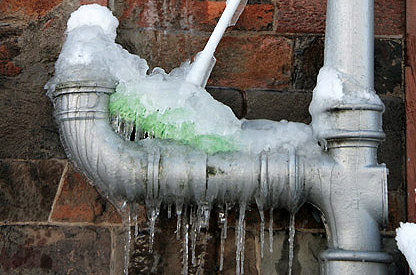The article underneath involving How to Prevent Your Pipes From Freezing is unquestionably enjoyable. Give it a go and make your own findings.

Winter can ruin your pipes, specifically by freezing pipelines. Below's just how to avoid it from occurring and what to do if it does.
Introduction
As temperature levels decline, the danger of frozen pipelines boosts, potentially resulting in costly fixings and water damages. Comprehending how to stop frozen pipelines is important for property owners in cool climates.
Understanding Icy Pipes
What triggers pipes to freeze?
Pipes freeze when exposed to temperature levels listed below 32 ° F (0 ° C) for extended durations. As water inside the pipes freezes, it expands, taxing the pipe wall surfaces and potentially triggering them to burst.
Threats and damages
Frozen pipelines can result in water supply disturbances, residential property damage, and expensive fixings. Burst pipelines can flood homes and trigger considerable structural damage.
Indicators of Frozen Pipeline
Recognizing frozen pipelines early can prevent them from rupturing.
Exactly how to recognize frozen pipelines
Seek reduced water circulation from faucets, uncommon smells or noises from pipelines, and noticeable frost on revealed pipelines.
Prevention Tips
Insulating prone pipes
Wrap pipes in insulation sleeves or make use of warm tape to safeguard them from freezing temperatures. Concentrate on pipes in unheated or external locations of the home.
Heating techniques
Keep indoor areas adequately heated, especially areas with plumbing. Open closet doors to permit warm air to circulate around pipes under sinks.
Protecting Exterior Pipes
Garden tubes and outdoor taps
Detach and drain garden tubes before winter. Set up frost-proof spigots or cover outdoor taps with protected caps.
What to Do If Your Pipelines Freeze
Immediate actions to take
If you believe frozen pipes, maintain taps open to soothe pressure as the ice melts. Utilize a hairdryer or towels soaked in hot water to thaw pipelines gradually.
Long-Term Solutions
Structural changes
Think about rerouting pipelines far from outside walls or unheated areas. Include added insulation to attics, basements, and crawl spaces.
Upgrading insulation
Purchase premium insulation for pipelines, attic rooms, and wall surfaces. Correct insulation aids preserve constant temperatures and minimizes the threat of icy pipelines.
Conclusion
Avoiding frozen pipes calls for aggressive actions and quick responses. By recognizing the reasons, indications, and preventive measures, home owners can secure their plumbing during winter.
6 Proven Ways to Prevent Frozen Pipes and Protect Your Home
Disconnect and Drain Garden Hoses
Before winter arrives, start by disconnecting your garden hoses and draining any remaining water. Close the shut-off valves that supply outdoor hose bibs and leave the outdoor faucet open to allow any residual water to drain. For extra protection, consider using faucet covers throughout the colder months. It’s also important to drain water from any sprinkler supply lines following the manufacturer’s directions.
Insulate Exposed Pipes
Insulating your pipes is an effective way to prevent freezing. Pipe insulation is readily available at home improvement stores and is relatively inexpensive. Pay close attention to pipes in unheated areas such as the attic, basement, crawl spaces, or garage. Apply foam insulation generously to create a buffer against the cold. You can also wrap your pipes in heat tape or thermostat-controlled heat cables for added warmth.
Seal Air Leaks
Inspect your home for any cracks or openings that could let in cold air. Seal any holes around the piping in interior or exterior walls, as well as the sill plates where your home rests on its foundation. Additionally, make sure to keep your garage door closed unless you’re entering or exiting. Leaving it open creates a significant air leak that can lead to frozen pipes.
Allow Warm Air Circulation
During cold snaps, it’s essential to allow warm air to circulate evenly throughout your home. Leave interior doors ajar to promote better airflow. Open kitchen and bathroom cabinets to help distribute heat consistently around the rooms. If you have small children or pets, be sure to remove any household chemicals or potentially harmful cleaners from open cabinets for safety.
Let Faucets Drip
A small trickle of water can make a big difference in preventing ice formation inside your pipes. When temperatures drop significantly, start a drip of water from all faucets served by exposed pipes. This continuous flow helps prevent the water from freezing. Additionally, running a few faucets slightly can relieve pressure inside the pipes, reducing the chances of a rupture if the water inside does freeze.
https://choateshvac.com/6-proven-ways-to-prevent-frozen-pipes-and-protect-your-home/

We were introduced to that editorial on How to prepare your home plumbing for winter weather through a friend on a different web page. I beg you take the opportunity to distribute this write-up if you appreciated it. I am grateful for your time. Revisit us soon.
Customer Reviews